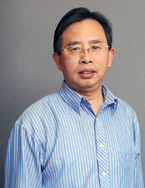| Donggao Zhao Home Electron Microbeam Diamonds and Mantle Xenoliths Nuclear Waste Mgmt. Teaching Publications (pdf) |
 Lecturer & Research Scientist
Contact:
Nuclear Waste ManagementDr. Donggao Zhao A second project of nuclear waste management is borosilicate glass as a waste form for the disposal of high-level nuclear waste. The objective of my research effort is to understand the distributions and solubilities of radionuclides and neutron absorbers in glass waste forms. The results will provide the knowledge for developing, evaluating, selecting, and matching waste forms for the safe disposal of various wastes associated with Pu, miscellaneous spent nuclear fuels (SNF), and other transuranic (TRU) wastes and for developing deterministic model for the long-term performance assessment of radionuclide containment. One manuscript from this project has also been submitted for publication.
Useful Links
|
|
|